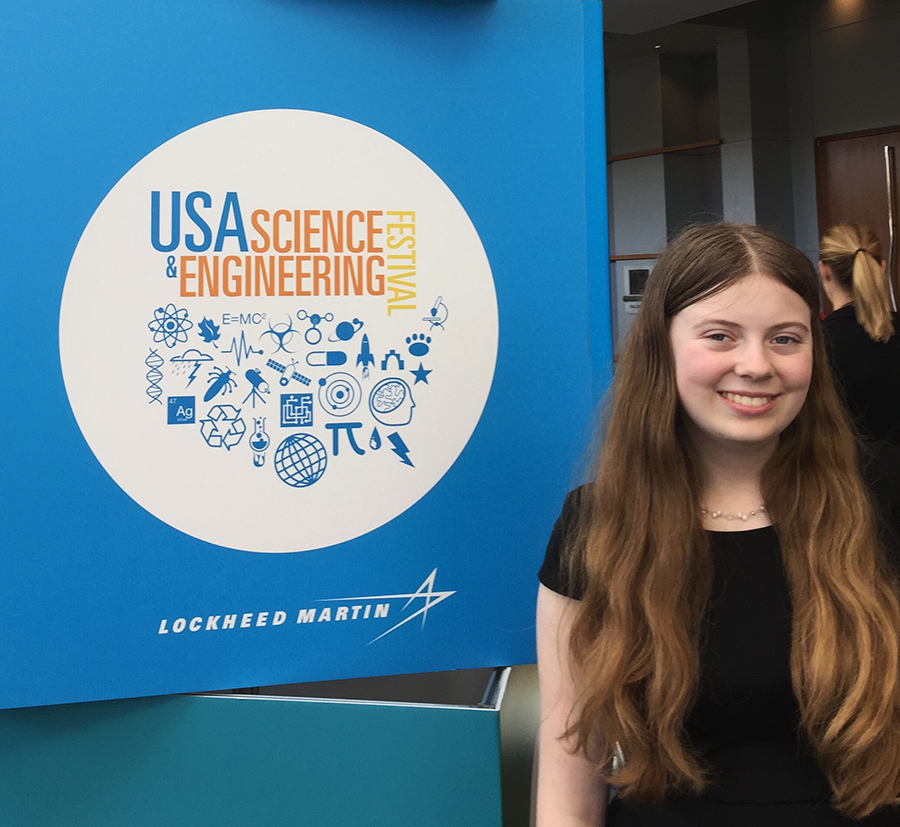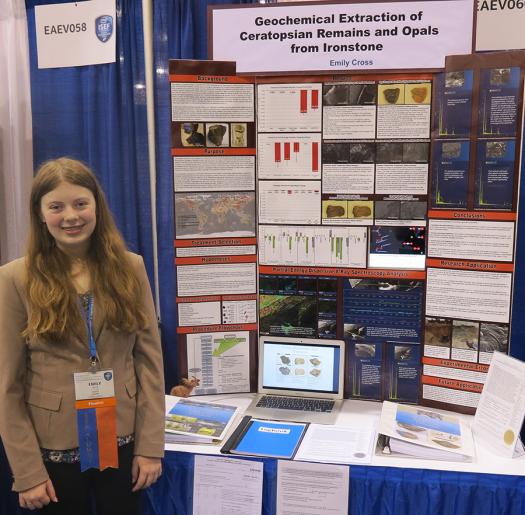‘As soon as I could walk, I started to collect rocks’

Emily Cross, a Society alumna from Ontario, Canada, studies fossils, specifically chemical processes to better break them down, without damaging fossilized preserved tissues. Her research may even improve the mining process. Recently, Emily participated in the X-STEM USA Science and Engineering Festival in Washington, D.C. and gave a keynote speech.
Emily has competed in science fairs since third grade. She competed in Intel ISEF in 2015 and 2016, and in 2015 won a first place Special Award from the American Geoscience Institute and fourth place for the Grand Award in the Earth and Environmental Science category. Her project, “Patination of Raw Lithic Materials for Analysis of Prehistoric Artifacts,” was the culmination of nine months of experiments and research on the chemical and physical analysis of prehistoric stone tools.
Read on to learn more about Emily’s research, and why she feels it’s important to encourage others into STEM.
WHY SHE RESEARCHES FOSSILS AND AIR POLLUTANTS: The fossil research is on a type of rock called ironstone. It is a really “hard” rock – so hard that paleontologists have a hard time removing fossils from it without a lot of time and effort, and some damage to the fossil.
My current STEM goal is to become a vertebrate paleontologist who uses chemistry, biology, and physics to determine how prehistoric creatures lived.
I discovered a chemical process that can break down and soften the ironstone without damaging the fossil, or any potentially fossilized preserved tissues. I also discovered a chemical process that can break down and soften a slightly different ironstone that boulder opals are found in, which can help improve the mining process.
For my air pollution research, I successfully designed and tested an air purification system that can transfer air pollutants, like heavy metals, to water. Then [the system] uses an aquatic invertebrate to remove the pollutants from the water.
There is a place for everyone in STEM!
ON GIVING A KEYNOTE SPEECH AT X-STEM: The festival was incredible. I got to meet and listen to many of the other speakers and their messages. An overwhelming theme was that there is a place for everyone in STEM! Giving a keynote presentation was really amazing! There was a question and answer period after the speech, and just hearing how much I had inspired kids to keep following their passions and to try STEM was incredible. There were so many great questions like had I ever failed before? The answer was yes – that motivated the kids, and in return, motivated me to persevere with my research, no matter the obstacle! I also got to sign trading cards of myself which was pretty cool.
HER CURRENT STEM GOALS: My current STEM goal is to become a vertebrate paleontologist who uses chemistry, biology, and physics to determine how prehistoric creatures lived, how they influenced modern species, and ease in extraction processes.

ON THE IMPORTANCE OF SCIENCE FAIRS: As soon as I got to Intel ISEF, I felt motivated to continue with STEM. The atmosphere was so encouraging to all of us youth scientists. Intel ISEF motivated me to explore other areas of science that I probably would not have otherwise done so. It also encouraged me to think about how I could apply these other fields to research that I was already doing. It definitely also encouraged me to promote STEM to others! I go around to elementary classes in my city and talk about the benefits of STEM and youth researchers, and I always show the Intel ISEF highlights video.
HER MOST MEMORABLE MOMENT AT INTEL ISEF: I think the most memorable moment of Intel ISEF was in 2015, when Raymond and Nicole won and we sang “Oh Canada.” It made me feel proud to be Canadian, and proud to be a member of Team Canada!
Speaking to the team at the project beside me in 2015 was also very memorable. They were from Malaysia and experienced a very different lifestyle! It was really interesting to compare our different cultures, but notice that through it all, the science could be communicated the same!
The atmosphere at Intel ISEF was so encouraging to all of us youth scientists.
HOW SHE FIRST BECAME INTERESTED IN STEM: I have always been interested in STEM! Pretty much as soon as I could walk, I started to collect rocks. I always asked the question “why?” The moment I realized that I wanted to be a scientist was when I went to the Royal Tyrrell Museum when I was seven and I saw the technicians working in the prep lab and learned about all of the research.
Pretty much as soon as I could walk, I started to collect rocks.
HER ADVICE TO OTHERS INTERESTED IN STEM: I would say to explore your passions. You never know how much you could really enjoy something until you try! There may be people who say that you aren’t good enough, but I always believe that simply having a passion makes you good enough!


